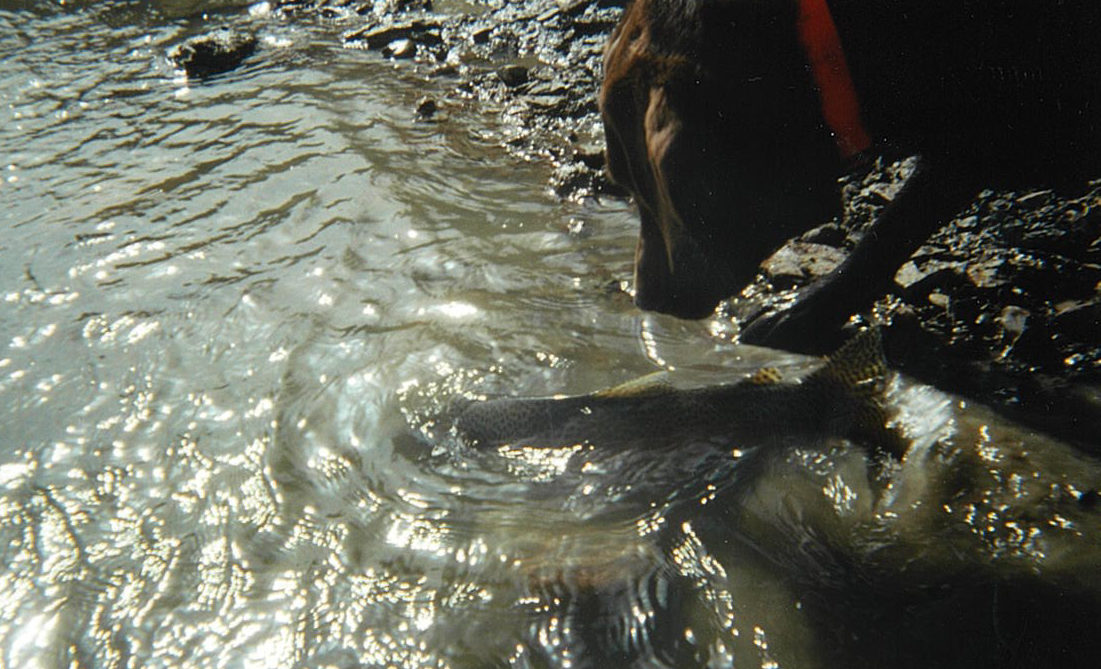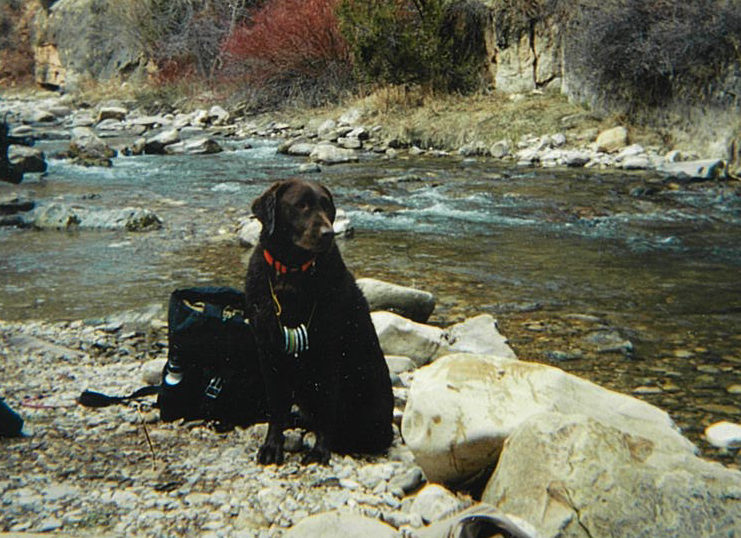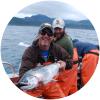On a sticky, hot day in August 1999, I moved into a nondescript one-bedroom house in Casper, Wyoming. I had been hired to teach composition at the local community college. I didn’t rent a U-Haul to bring my belongings. Instead, I stacked my duck decoys, waders, boxes of books, and laundry baskets of clothes into a sixteen-foot ClackaCraft and drove north. Before I unpacked my boxes, arranged for cable television, or walked to campus to check out my new office, I grabbed my fly rod and headed out to the fabled stretch of trout water below Gray Reef dam. Sweets, my one-year-old chocolate Lab, enlivened when she saw me throw my waders, fly vest, and boots into the bed of the truck. A trained duck dog, she loved to come on fishing trips where she waded in up to her skid plate, harassed muskrats, or flopped in the shallow back eddies to cool off. In these moments, she closed her eyes lightly and seemed to dream, or show some of the sign of ecstasy that is missing in most people. Finally, after a year living in another state, we were back in Wyoming, living within walking distance of a river I had only read about in magazines.
I stopped by a local fly shop and asked for advice. I usually do this when I fish a new place. The owner was there that day. He sold me a plastic cup of tiny midges and a few undignified red rock worms in size sixteen. He told me to fish as close to the dam stretch as possible. He insisted I take a roll of heavy tippet with me. “These fish are not leader shy, and they’ll saw you off if you use the light stuff,” he said. I had heard it all before, but I bought some 3X tippet. I was, after all, new here.

When I pulled into the parking lot I discovered a tent city of anglers who had drifted up, primarily, from Colorado, but there were Utah and California license plates on some of the cars too. They were a grizzled lot of trout bums, refugees who had somehow finagled a week off from their jobs to stand waist-deep in the river and cast all day long. I watched them fish for a while and was amazed by the single-mindedness of their movements. I marveled at the way they focused on the water before them, changed flies without coming to shore, and seemed to miss the real world going on around them. Did they see the mergansers feeding on fry in the shallows? Did they note the thunderheads building in the west? These guys had no interest in me or my dog. In fact, when Sweets dared to approach a man who was releasing a rainbow trout, he shooed her away with rough words.
I can’t say I knocked them dead that first day. (I hardly ever knock them dead.) But I hooked a few fish and saw my light tippet part immediately. I switched over to the heavy stuff and, as the thunderstorm boiled overhead and the dust in the parking lot took flight, I caught my first rainbow from the North Platte. It was a gorgeous sixteen inch fish that tested my drag and made several convincing runs, like summer fish do. Sweets crowded me as I was trying to release the fish. She licked it, which is what she usually did right before she tried to take a bite.
“Fishing dogs,” said a voice from nearby, “they’re fun to have around but they make things difficult.” It was the fisherman who had been rude earlier. Now he was smiling and looking down at my dog. He complimented my fish and I told him I had just moved to Casper.
“You’re going to dig it,” he said. He sauntered off downstream, the thunder and lightning seemingly having no effect upon him.

I felt victorious as I crawled out of my waders and into my battered Nissan. I drove back to town refreshed and convinced that I had made the right move in coming back to Wyoming. The Cast is a monthly newsletter that celebrates the North Platte River and the fly fishing culture that has sprung up in the middle of Wyoming. Recently the famous novelist and fly fishing writer Thomas McGuane compared writing for a career to implicitly agreeing to forty years of subsistence living. Which is to say, upfront and clearly, that I am a working writer and this is a paid gig. It’s hard to get published, and even more difficult to get paid for writing. And when you do, you should be honest about it.
It’s January now and things are quiet on the river. If you are one of those dedicated people who catch a trout per month, every month as some sort of self-imposed punishment, you’re glad to see a mild winter because it means plenty of open water. Out among the ducks and geese, you’ll do your thing. And I’ll do mine. The flows are as low as they get and the shelf ice keeps most of us at home. The water is a gin clear and the fish will feed. Your best bet is to go small, use those size 18 foam back nymphs that you can hardly see to tie on. Use midge patters that are composed of a few fibers and a tiny copper bead. There are winter days when an RS2 can wreak havoc on a pod of feeding rainbows. If a midge patter is in danger of taking to the breeze and blowing out of your palm, chances are, this is the one you should use in the deep winter. Truthfully, I am an average fisherman with questionable knot-tying habits and fly boxes that look ravished by someone in a hurry. My hands ache with cold this time of year, and I complain bitterly about ice in my guides. But I go. I go and I prevail, even if it hurts. This newsletter is not in the business of telling people how to fish. Or when to fish, for that matter. You could just as well, skip your January fish, and who would know the difference?
The Cast will avoid endorsing products, services and gizmos that have become so central to fly-fishing magazines. We will not encourage you to buy coolers that approach the going rate for a monthly mortgage. Instead, we will celebrate the outdoor opportunities around Casper and beyond. The Cast will pause to consider the natural beauty which we often take for granted, a ferruginous hawk for instance. A band of antelope does and fawns socializing in the nappy sage that frames, really, so much of our lives. This newsletter is for those who are not opposed to standing on the shelf-ice in January to see how the trout are doing. We will use this space to announce upcoming events, a place to connect with others in the trout-fishing community. We’ll offer profiles of people connected to the river, and have guest writers who will bring their own ideas into play. Who knows what we will do in this space? But if you have read this far you know that the literary style we are seeking requires a beginning, a middle, and an end. I tell my first year composition students this much.
The dog was suddenly older, bony. I hardly recognized her gaze. She wouldn’t eat. Sweets was dying of a number of things: extreme arthritis, failing kidneys, various cancers, and perhaps a broken heart at being replaced by a new puppy. I told myself that we had a good run, thirteen years, much of it spent along the river, and countless trips into the backcountry. But reciting these platitudes and actually doing something about them are two different things.

Sweets was with me the first time I laid eyes on Grey Reef. She was with me on so many of the obscure exhibitions that occupied the last twenty years of my life. In her prime, the dog was pure delight and appetite, a being so invested in the venial pleasures of the world that she often went into a trance while eating her kibble, especially if I took the time to drizzle some bacon grease over it. On Thanksgiving the dog wove through my legs because she knew I’d sacrifice my better judgement after several glasses of red wine, and give her the pan drippings, giblets and all. She nearly passed out after lapping up the whole greasy mess. Afterwards, she’d lay on the kitchen floor and snooze, paddling her feet as if she was crossing the river.
I could never cure her of the need to take a nip at a trout, nor could I keep her out of the trash. I couldn’t keep her from wandering off to meet other anglers. She was a reliable bird dog in the uplands of North Dakota, and she had a soft mouth on the mallards we took out near Bessemer Bend, when the river was frozen and there was no reason to fish. But she excelled mostly in March and April, on the banks of the North Platte, out along the public access areas, and deep into the dusty two-tracks of Trappers Route where we spent our lives. We knew where to go and, more or less, how to catch trout. Perhaps a fat chocolate Lab once ran up to you and greeted you when you were getting into your waders?
Sweets busied herself in the willows, moussing, terrorizing songbirds, enjoying the career of a fishing dog. But when I set hook and the fish leapt, she crowded me. She leaned on me while I fought the fish. Often, when I’m releasing a trout, I think of her. I can’t help but think of that dog and the river in the same breath. They are inseparable. To me they are the same.




